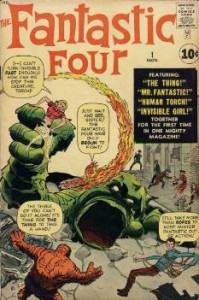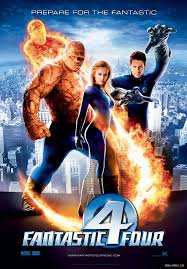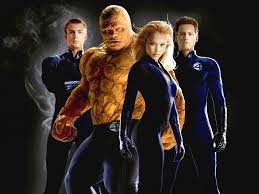Fantastic Four

Fantastic Four: World’s Greatest Heroes – #21
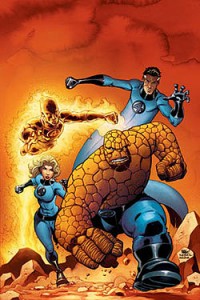 Promotional art for Fantastic Four #509 (March 2004) by Mike Wieringo and Karl Kesel.
Promotional art for Fantastic Four #509 (March 2004) by Mike Wieringo and Karl Kesel.
The Fantastic Four is a fictional superhero team appearing in comic bookspublished by Marvel Comics. The group debuted in The Fantastic Four #1 (cover dated Nov. 1961), which helped to usher in a new level of realism in the medium. The Fantastic Four was the first superhero team created by writer-editor Stan Lee and artist/co-plotter Jack Kirby, who developed a collaborative approach to creating comics with this title that they would use from then on. As the first superhero team title produced by Marvel Comics, it formed a cornerstone of the company’s 1960s rise from a small division of a publishing company to a pop culture conglomerate. The title would go on to showcase the talents of comics creators such as Roy Thomas, John Buscema, George Pérez, John Byrne, Steve Englehart, Walt Simonson, and Tom DeFalco, and is one of several Marvel titles originating in the Silver Age of Comic Books that is still in publication in the 2010s.
 The four individuals traditionally associated with the Fantastic Four, who gained superpowers after exposure to cosmic rays during a scientific mission to outer space, are: Mister Fantastic (Reed Richards), a scientific genius and the leader of the group, who can stretch his body into incredible lengths and shapes; the Invisible Woman (Susan “Sue” Storm), who eventually married Reed, who can render herself invisible and later project powerful force fields; the Human Torch (Johnny Storm), Sue’s younger brother, who can generate flames, surround himself with them and fly; and the monstrous Thing (Ben Grimm), their grumpy but benevolent friend, a former college football star and Reed’s college roommate as well as a good pilot, who possesses superhuman strength and endurance due to the nature of his stone-like flesh.
The four individuals traditionally associated with the Fantastic Four, who gained superpowers after exposure to cosmic rays during a scientific mission to outer space, are: Mister Fantastic (Reed Richards), a scientific genius and the leader of the group, who can stretch his body into incredible lengths and shapes; the Invisible Woman (Susan “Sue” Storm), who eventually married Reed, who can render herself invisible and later project powerful force fields; the Human Torch (Johnny Storm), Sue’s younger brother, who can generate flames, surround himself with them and fly; and the monstrous Thing (Ben Grimm), their grumpy but benevolent friend, a former college football star and Reed’s college roommate as well as a good pilot, who possesses superhuman strength and endurance due to the nature of his stone-like flesh.
Ever since their original 1961 introduction, the Fantastic Four have been portrayed as a somewhat dysfunctional, yet loving, family. Breaking convention with other comic book archetypes of the time, they would squabble and hold grudges both deep and petty, and eschewed anonymity or secret identities in favor of celebrity status. The team is also well known for its recurring encounters with characters such as the villainous monarch Doctor Doom, the planet-devouring Galactus, the sea-dwelling prince Namor, the spacefaring Silver Surfer, and the shape-changing alien Skrulls.
The Fantastic Four have been adapted into other media, including four animated television series, an aborted 1990’s low-budget film, and the studio motion pictures Fantastic Four (2005) and Fantastic Four: Rise of the Silver Surfer (2007). Areboot is in early development for a release date in 2015.
Apocryphal legend has it that in 1961, longtime magazine and comic bookpublisher Martin Goodman was playing golf with either Jack Liebowitz or Irwin Donenfeld of rival company DC Comics, then known as National Periodical Publications, and that the top executive bragged about DC’s success with the new superhero team the Justice League of America. While film producer and comics historian Michael Uslan has debunked the particulars of that story, Goodman, a publishing trend-follower, aware of the JLA’s strong sales, did direct his comics editor, Stan Lee, to create a comic-book series about a team of superheroes. According to Lee, writing in 1974, “Martin mentioned that he had noticed one of the titles published by National Comics seemed to be selling better than most. It was a book called The [sic] Justice League of America and it was composed of a team of superheroes. … ‘If the Justice League is selling’, spoke he, ‘why don’t we put out a comic book that features a team of superheroes?'”
Lee, who had served as editor-in-chief and art director of Marvel Comics and its predecessor companies, Timely Comics and Atlas Comics, for two decades, found that the medium had become creatively restrictive. Determined “to carve a real career for myself in the nowhere world of comic books, Lee concluded that, “For just this once, I would do the type of story I myself would enjoy reading…. And the characters would be the kind of characters I could personally relate to: they’d be flesh and blood, they’d have their faults and foibles, they’d be fallible and feisty, and — most important of all — inside their colorful, costumed booties they’d still have feet of clay.”
Lee said he created a synopsis for the first Fantastic Four story that he gave to penciller Jack Kirby, who then drew the entire story. Kirby turned in his penciled art pages to Lee, who added dialogue and captions. This approach to creating comics, which became known as the “Marvel Method“, worked so well for Lee and Kirby that they used it from then on; the Marvel Method became standard for the company within a year.
Kirby recalled events somewhat differently. Challenged with Lee’s version of events in a 1990 interview, Kirby responded: “I would say that’s an outright lie,” although the interviewer, Gary Groth notes that this statement needs to be viewed with caution. Kirby claims he came up with the idea for the Fantastic Four in Marvel’s offices, and that Lee had merely added the dialogue after the story had been pencilled. Kirby has also sought to establish, more credibly and on numerous occasions, that the visual elements of the strip were his conceptions. He regularly pointed to a team he had created for rival publisher DC Comics in the 1950s, Challengers of the Unknown. “[I]f you notice the uniforms, they’re the same… I always give them a skintight uniform with a belt… the Challengers and the FF have a minimum of decoration. And of course, the Thing’s skin is a kind of decoration, breaking up the monotony of the blue uniform.” The characters wear no uniforms in the first two issues.
Given the conflicting statements, outside commentators have found it hard to identify with precise detail who created the Fantastic Four. Although Stan Lee’s typed synopsis for the Fantastic Four exists, Earl Wells, writing in The Comics Journal, points out that its existence doesn’t assert its place in the creation; “[W]e have no way of knowing of whether Lee wrote the synopsis after a discussion with Kirby in which Kirby supplied most of the ideas.” Comics historian R. C. Harvey believes that the Fantastic Four was a furtherance of the work Kirby had been doing previously, and so “more likely Kirby’s creations than Lee’s.” But Harvey notes that the Marvel Method of collaboration allowed each man to claim credit, and that Lee’s dialogue added to the direction the team took. Wells argues that it was Lee’s contributions which set the framework within which Kirby worked, and this made Lee “more responsible.” Comics historian Mark Evanier, a studio assistant to Jack Kirby in the 1970s, says that the considered opinion of Lee and Kirby’s contemporaries was “that Fantastic Four was created by Stan and Jack. No further division of credit seemed appropriate.”
The release of The Fantastic Four #1 (Nov. 1961) was an unexpected success. Lee had felt ready to leave the comics field at the time, but the positive response to Fantastic Four persuaded him to stay on. The title began to receive fan mail, and Lee started printing the letters in a letter column with issue #3. Also with the third issue, Lee created the hyperbolic slogan “The Greatest Comic Magazine in the World!!” With the following issue, the slogan was changed to “The World’s Greatest Comic Magazine!” and became a fixture on the issue covers into the 1990’s, and on numerous covers in the 2000’s.
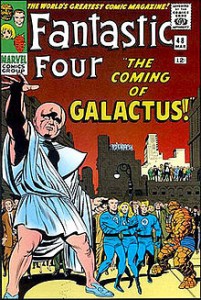 Fantastic Four #48 (Sept. 1966): The Watcher warns, in part one of the landmark “Galactus Trilogy“. Cover art by Kirby and Joe Sinnott.
Fantastic Four #48 (Sept. 1966): The Watcher warns, in part one of the landmark “Galactus Trilogy“. Cover art by Kirby and Joe Sinnott.
Issue #4 (May 1962) reintroduced Namor the Sub-Mariner, an aquatic antihero who was a star character of Marvel’s earliest iteration, Timely Comics, during the late 1930s and 1940s period that historians and fans call the Golden Age of Comics. Issue #5 (July 1962) introduced the team’s most frequent nemesis, Doctor Doom. These earliest issues were published bimonthly. With issue #16 (July 1963), the cover title dropped itsThe and became simply Fantastic Four.
While the early stories were complete narratives, the frequent appearances of these two antagonists, Doom and Namor, in subsequent issues indicated the creation of a long narrative by Lee and Kirby that extended over months. Ultimately, according to comics historian Les Daniels, “only narratives that ran to several issues would be able to contain their increasingly complex ideas.” During its creators’ lengthy run, the series produced many acclaimed storylines and characters that have become central to Marvel, including the hidden race of alien-human genetic experiments, theInhumans; the Black Panther, an African king who would be mainstream comics’ first black superhero; the rival alien races the Kree and the shapeshifting Skrulls; Him, who would become Adam Warlock; the Negative Zone; and unstable molecules. The story frequently cited as Lee and Kirby’s finest achievement is the three-part “Galactus Trilogy” that began in Fantastic Four #48 (March 1966), chronicling the arrival of Galactus, a cosmic giant who wanted to devour the planet, and his herald, the Silver Surfer. Fantastic Four #48 was chosen as #24 in the 100 Greatest Marvels of All Time poll of Marvel’s readers in 2001. Editor Robert Greenbergerwrote in his introduction to the story that “As the fourth year of the Fantastic Four came to a close, Stan Lee and Jack Kirby seemed to be only warming up. In retrospect, it was perhaps the most fertile period of any monthly title during the Marvel Age.” Daniels noted that “[t]he mystical and metaphysical elements that took over the saga were perfectly suited to the tastes of young readers in the 1960’s,” and Lee soon discovered that the story was a favorite on college campuses. The Fantastic Four Annual was used to spotlight several key events. The Sub-Mariner was crowned king of Atlantis in the first annual (1963). The following year’s annual revealed the origin story of Doctor Doom. Fantastic Four Annual #3 (1965) presented the wedding of Reed Richards and Sue Storm. Lee and Kirby reintroduced the original Human Torch in Fantastic Four Annual #4 (1966) and had him battle Johnny Storm. Franklin Richards was born in Fantastic Four Annual #6 (1968) in a story which introduced Annihilus as well.
 Marvel filed for a trademark for “Fantastic Four” in 1967, and the United States Patent and Trademark Office issued the registration in 1970.
Marvel filed for a trademark for “Fantastic Four” in 1967, and the United States Patent and Trademark Office issued the registration in 1970.
Kirby left Marvel in mid 1970, having drawn the first 102 issues plus an unfinished issue later completed and published asFantastic Four: The Lost Adventure (April 2008), Fantastic Four continued with Lee, Roy Thomas, Gerry Conway and Marv Wolfman as its consecutive regular writers, working with artists such as John Romita, Sr., John Buscema, Rich Buckler andmGeorge Pérez, with longtime inker Joe Sinnott adding some visual continuity. Jim Steranko also contributed several covers during this time. A short-lived series titled Giant-Size Super-Stars starring the team began in May 1974 and changed its title to Giant-Size Fantastic Four with issue #2. The fourth issue introduced Jamie Madrox, a character who later became part of the X-Men. Giant-Size Fantastic Four was canceled with issue #6 (Oct. 1975). Roy Thomas and George Pérez crafted a metafictional story for Fantastic Four #176 (Nov. 1976) in which the Impossible Man visited the offices of Marvel Comics and met numerous comics creators. John Byrne joined the title with issue #209 (Aug. 1979), doing pencil breakdowns for Sinnott to finish. He and Wolfman introduced a new herald for Galactus named Terrax in #211 (Oct. 1979).
Bill Mantlo briefly followed Wolfman as writer of the series and wrote a crossover with Peter Parker, The Spectacular Spider-Man#42 (May 1980). Byrne then wrote two tales as well (#220-221, July–Aug. 1980) before writer Doug Moench and penciller Bill Sienkiewicz took over for 10 issues. With issue #232 (July 1981), the aptly titled “Back to the Basics,” Byrne began his run as writer, penciller and inker, the last under the pseudonym Bjorn Heyn for this issue only.
Byrne revitalized the slumping title with his run. Originally, Byrne was slated to write with Sienkiewicz providing the art. Sienkiewicz left to do Moon Knight, and Byrne ended up as writer, artist, and inker. Various editors were assigned to the comic; eventually Bob Budiansky became the regular editor. Byrne told Jim Shooter that he could not work with Budiansky, although they ultimately continued to work together. In 2006, Byrne said “that’s my paranoia. I look back and I think that was Shooter trying to force me off the book”. Byrne left following issue #293 (Aug. 1986) in the middle of a story arc, explaining he could not recapture the fun he had previously had on the series. One of Byrne’s changes was making the Invisible Girl into the Invisible Woman: assertive and confident. During this period, fans came to recognize that she was quite powerful, whereas previously, she had been primarily seen as a superpowered mother and wife in the tradition of television moms like those played by Donna Reed and Florence Henderson.
Byrne staked new directions in the characters’ personal lives, having the married Sue Storm and Reed Richards suffer a miscarriage, and the Thing quitting the Fantastic Four, with She-Hulk being recruited as his long-term replacement.
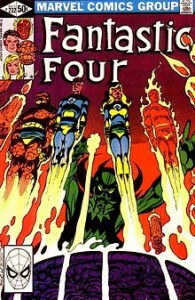 John Byrne gets “Back to the Basics” in #232 (July 1981), his debut as writer-artist. Cover art by Byrne and inker Terry Austin.
John Byrne gets “Back to the Basics” in #232 (July 1981), his debut as writer-artist. Cover art by Byrne and inker Terry Austin.
Byrne was followed by a quick succession of writers: Roger Stern, Tom DeFalco, and Roy Thomas. Steve Englehart took over as writer for issues 304–332 (except #320). The title had been struggling, so Englehart decided to make radical changes. He felt the title had become stale with the normal makeup of Reed, Sue, Ben, and Johnny, so in issue #308 Reed and Sue retired and were replaced with the Thing’s new girlfriend, Sharon Ventura, and Johnny Storm’s former love, Crystal. The changes increased readership through issue #321. At this point, Marvel made decisions about another Englehart comic, West Coast Avengers, that he disagreed with, and in protest he changed his byline to S.F.X. Englehart (S.F.X. is the abbreviation for Simple Sound Effects). In issue #326, Englehart was told to bring Reed and Sue back and undo the other changes he had made. This caused Englehart to take his name entirely off the book. He used the pseudonym John Harkness, which he had created years before for work he didn’t want to be associated with. According to Englehart, the run from #326 through his last issue, #332, was “one of the most painful stretches of [his] career. Writer-artist Walt Simonson took over as writer with #334 (December 1989), and three issues later began pencilling and inking as well. With brief inking exceptions, two fill-in issues, and a three-issue stint drawn by Arthur Adams, Simonson remained in all three positions through #354 (July 1991).
 Simonson, who had been writing the team comic The Avengers, had gotten approval for Reed and Sue to join that team after Engelhart had written them out of Fantastic Four. Yet by The Avengers #300, where they were scheduled to join the team, Simonson was told the characters were returning to Fantastic Four. This led to Simonson quitting The Avengers after that issue. Shortly afterward, he was offered the job of writing Fantastic Four. Having already prepared a number of stories involving the Avengers with Reed and Sue in the lineup, he then rewrote these for Fantastic Four. Simonson later recalled that working on Fantastic Four allowed him the latitude to use original Avengers members Thor and Iron Man, which he had been precluded from using in The Avengers.
Simonson, who had been writing the team comic The Avengers, had gotten approval for Reed and Sue to join that team after Engelhart had written them out of Fantastic Four. Yet by The Avengers #300, where they were scheduled to join the team, Simonson was told the characters were returning to Fantastic Four. This led to Simonson quitting The Avengers after that issue. Shortly afterward, he was offered the job of writing Fantastic Four. Having already prepared a number of stories involving the Avengers with Reed and Sue in the lineup, he then rewrote these for Fantastic Four. Simonson later recalled that working on Fantastic Four allowed him the latitude to use original Avengers members Thor and Iron Man, which he had been precluded from using in The Avengers.
After another fill-in, the regular team of writer and Marvel editor-in-chief Tom DeFalco, penciller Paul Ryan and inker Dan Bulanadi took over, with Ryan self-inking beginning with #360 (Jan. 1992). That team, with the very occasional different inker, continued for years through #414 (July 1996). DeFalco nullified the Storm-Masters marriage by retconning that the alien Skrull Empire had kidnapped the real Masters and replaced her with a spy named Lyja. Once discovered, Lyja, who herself had fallen for Storm, helped the Fantastic Four rescue Masters. Ventura departed after being further mutated by Doctor Doom. Although some fans were not pleased with DeFalco’s run on Fantastic Four, calling him “The Great Satan”, the title’s sales increased over the period.
Other key developments included Franklin Richards being sent into the future and returning as a teenager; the return of Reed’s time-traveling father, Nathaniel, who is revealed to be the father of time-travelling villain Kang; and Reed’s apparent death at the hands of a seemingly mortally wounded Doctor Doom. It would be two years before DeFalco resurrected the two characters, revealing that their “deaths” were orchestrated by the supervillain Hyperstorm.
The ongoing series was canceled with issue #416 (Sept. 1996) and relaunched with vol. 2, #1 (Nov. 1996) as part of the multi-series “Heroes Reborn” crossover story arc. The yearlong volume retold the team’s first adventures in a more contemporary style, and set in a parallel universe. Following the end of that experiment, Fantastic Four was relaunched with vol. 3, #1 (Jan. 1998). Initially by the team of writer Scott Lobdell and penciller Alan Davis, it went after three issues to writer Chris Claremont (co-writing with Lobdell for #4-5) and penciller Salvador Larroca; this team enjoyed a long run through issue #32 (Aug. 2000).

